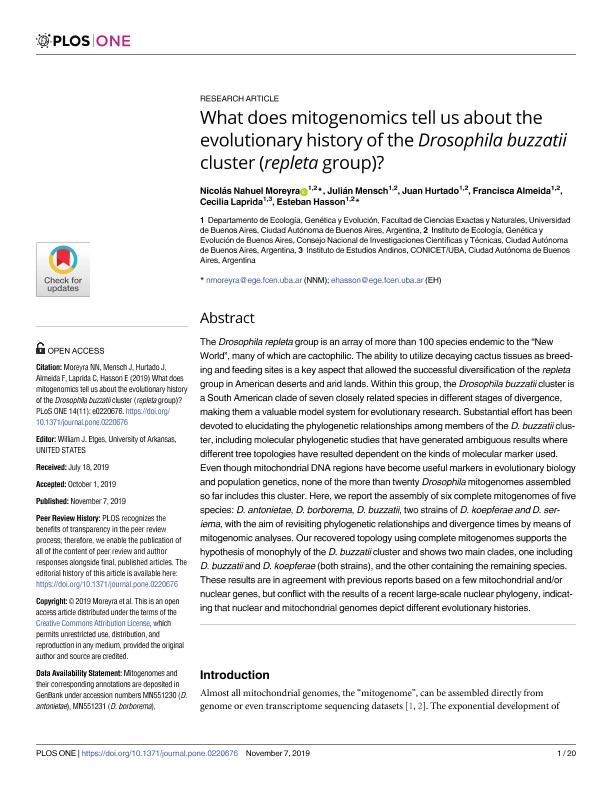Artículo
What does mitogenomics tell us about the evolutionary history of the Drosophila buzzatii cluster (repleta group)?
Moreyra, Nicolás Nahuel ; Mensch, Julian
; Mensch, Julian ; Hurtado, Juan Pablo
; Hurtado, Juan Pablo ; Cunha Almeida, Francisca
; Cunha Almeida, Francisca ; Laprida, Cecilia
; Laprida, Cecilia ; Hasson, Esteban Ruben
; Hasson, Esteban Ruben
 ; Mensch, Julian
; Mensch, Julian ; Hurtado, Juan Pablo
; Hurtado, Juan Pablo ; Cunha Almeida, Francisca
; Cunha Almeida, Francisca ; Laprida, Cecilia
; Laprida, Cecilia ; Hasson, Esteban Ruben
; Hasson, Esteban Ruben
Fecha de publicación:
11/2019
Editorial:
Public Library of Science
Revista:
Plos One
ISSN:
1932-6203
Idioma:
Inglés
Tipo de recurso:
Artículo publicado
Clasificación temática:
Resumen
The Drosophila repleta group is an array of more than 100 species endemic to the “New World”, many of which are cactophilic. The ability to utilize decaying cactus tissues as breeding and feeding sites is a key aspect that allowed the successful diversification of the repleta group in American deserts and arid lands. Within this group, the Drosophila buzzatii cluster is a South American clade of seven closely related species in different stages of divergence, making them a valuable model system for evolutionary research. Substantial effort has been devoted to elucidating the phylogenetic relationships among members of the D. buzzatii cluster, including molecular phylogenetic studies that have generated ambiguous results where different tree topologies have resulted dependent on the kinds of molecular marker used. Even though mitochondrial DNA regions have become useful markers in evolutionary biology and population genetics, none of the more than twenty Drosophila mitogenomes assembled so far includes this cluster. Here, we report the assembly of six complete mitogenomes of five species: D. antonietae, D. borborema, D. buzzatii, two strains of D. koepferae and D. seriema, with the aim of revisiting phylogenetic relationships and divergence times by means of mitogenomic analyses. Our recovered topology using complete mitogenomes supports the hypothesis of monophyly of the D. buzzatii cluster and shows two main clades, one including D. buzzatii and D. koepferae (both strains), and the other containing the remaining species. These results are in agreement with previous reports based on a few mitochondrial and/or nuclear genes, but conflict with the results of a recent large-scale nuclear phylogeny, indicating that nuclear and mitochondrial genomes depict different evolutionary histories.
Palabras clave:
Evolution
,
Drosophila
,
Climatic changes
Archivos asociados
Licencia
Identificadores
Colecciones
Articulos(IDEAN)
Articulos de INSTITUTO DE ESTUDIOS ANDINOS "DON PABLO GROEBER"
Articulos de INSTITUTO DE ESTUDIOS ANDINOS "DON PABLO GROEBER"
Articulos(IEGEBA)
Articulos de INSTITUTO DE ECOLOGIA, GENETICA Y EVOLUCION DE BS. AS
Articulos de INSTITUTO DE ECOLOGIA, GENETICA Y EVOLUCION DE BS. AS
Citación
Moreyra, Nicolás Nahuel; Mensch, Julian; Hurtado, Juan Pablo; Cunha Almeida, Francisca; Laprida, Cecilia; et al.; What does mitogenomics tell us about the evolutionary history of the Drosophila buzzatii cluster (repleta group)?; Public Library of Science; Plos One; 14; 11; 11-2019; 1-20
Compartir
Altmétricas



